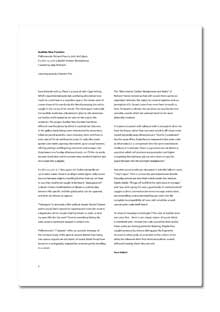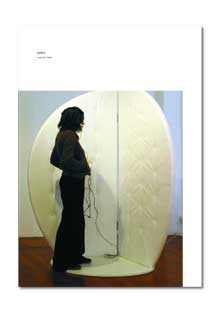 |
|||||||||
|
|
| ...Publications: Annual | ...Audible - Essay by Susan Ballard | ||||||||||||||
|
Audible: New Frontiers Listening posts by Valentin Tinc Sound travels with us. There is a story of John Cage visiting NASA's experimental audio lab, and being shocked at how much he could hear in a soundless space. The noises were of course those of his own body, the blood pumping, the saliva caught in the corner of his mouth. The silent space had made him audible. Audio has a fluorescent glow to it; it penetrates our bodies and is tasted by our ears on the w ay to the cerebrum. The project Audible: New Frontiers had three different manifestations by which it could attract listeners . In the gallery track listings were determined by movement, a listener paced around a room, choosing when and how to enter one of the six smithsonite pods. On radio the works spread over weeks, opening themselves up to casual listeners, offering pairings and lingering memories and unexpected disturbance to a Sunday afternoon. Lastly, on CD the six works became fixed, time and movement were rendered familiar and structured into a playlist. R a d i o q u a l i a' s "data.space.rtn" holds a butterfly net up to radio waves. Noise is an all pervasive signal, radio waves bounce between objects travelling further than we can hear or see, they need to be caught to be heard. "data.space.rtn" is about chance manifestations of distance, and the play between the specific and the global, what can be captured, and what we choose to capture. "Poltergeist" is obviously a film without visuals . Rachel Shearer points sound back towards its supernatural roots, the result is a liquidation of the visual. I hold my breath in order to shut my eyes. Did she trip over? There is something hitting the walls, noise is repressed, trapped in a black box. Philharmonic's "7 airports" offers an acoustic melange of the technical body of the generic air port. Rather than being non-spaces airports are stockpiles of sound. Music found here becomes a cartography, mapped by someone gently doodling in a corner. The "Slow Interior Circles/ Headphones and Radio" of Richard Francis remind us that with sound there can be no separation between the object, its material qualities and our perception of it. Sound comes from over there to touch us, here. Designed to vibrate, the ear drum can quickly become unstable, sounds which are unheard become the most physically insistent. A chance encounter with talkback radio is enough to drive me from the house, rather than turn and switch it off I must move myself physically away. Wendyhouse’s "Skull & Crossphones" has the same effect. Noise here is measured in the same units as information, it is compressed into the same transmission mediums, it is entropic. Chaos is a presence not an absence, a positive which will promote reorganisation and higher complexity. Wendyhouse ask just what does occupy the space between the left and right headphones? Narrative sound worlds are disrupted in John McCallum's work "Tony's tapes". Time is contracted, and experienced double . Everyday actions are described which render the medium highly visible. "I'll sign off and find the right place in my tape" and "you were saying this was a good mode of communication " suggest a direct connection bet ween message and receiver, but misreadings and understandings pervade. Like the complete incompatibility of irony with email, the unsaid cannot quite make itself heard. So what of everyday technologies? The code of Audible does not come first, - there is not a basic matter of sound which is interfered with - instead the code crystallises from action, these works are starting points for listening . Maybe they caught someone by chance, sliding past the fragments encased in white pods, or, scratched on the surface of the ether, but whatever their final destination, these sounds will avoid staying where they are told. Susan Ballard View Audible: New Frontiers - Essay by Susan Ballard as a PDF This essay originally appeared in The Physics Room Annual 2003 Order your copy today from The Physics Room ! Related 19 August - 13 September 2003
|
||||||||||||||


